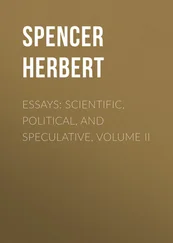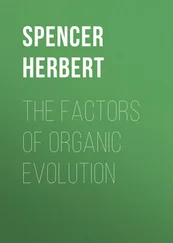Once more, in greater self-mobility a progressive differentiation is traceable. Dead matter is inert: some form of independent motion is our most general test of life. Passing over the indefinite border-land between the animal and vegetable kingdoms, we may roughly class plants as organisms which, while they exhibit the kind of motion implied in growth, are not only without locomotive power, but in nearly all cases are without the power of moving their parts in relation to one another; and thus are less differentiated from the inorganic world than animals. Though in those microscopic Protophyta and Protozoa inhabiting the water—the spores of algæ, the gemmules of sponges, and the infusoria generally—we see locomotion produced by ciliary action; yet this locomotion, while rapid relatively to their sizes, is absolutely slow. Of the Cœlenterata , a great part are either permanently rooted or habitually stationary, and so have scarcely any self-mobility but that implied in the relative movements of parts; while the rest, of which the common jelly-fish serves as a sample, have mostly but little ability to move themselves through the water. Among the higher aquatic Invertebrata —cuttle-fishes and lobsters, for instance—there is a very considerable power of locomotion; and the aquatic Vertebrata are, considered as a class, much more active in their movements than the other inhabitants of the water. But it is only when we come to air-breathing creatures that we find the vital characteristic of self-mobility manifested in the highest degree. Flying insects, mammals, birds, travel with velocities far exceeding those attained by any of the lower classes of animals; and so are more strongly contrasted with their inert environments.
Thus, on contemplating the various grades of organisms in their ascending order, we find them more and more distinguished from their inanimate media in structure , in form , in chemical composition , in specific gravity , in temperature , in self-mobility . It is true that this generalization does not hold with regularity. Organisms which are in some respects the most strongly contrasted with the inorganic world, are in other respects less contrasted than inferior organisms. As a class, mammals are higher than birds; and yet they are of lower temperature, and have smaller powers of locomotion. The stationary oyster is of higher organization than the free-swimming medusa; and the cold-blooded and less heterogeneous fish is quicker in its movements than the warm-blooded and more heterogeneous sloth. But the admission that the several aspects under which this increasing contrast shows itself bear variable ratios to one another, does not negative the general truth enunciated. Looking at the facts in the mass, it cannot be denied that the successively higher groups of organisms are severally characterized, not only by greater differentiation of parts, but also by greater differentiation from the surrounding medium in sundry other physical attributes. It would seem that this peculiarity has some necessary connexion with superior vital manifestations. One of those lowly gelatinous forms which are some of them so transparent and colourless as to be with difficulty distinguished from the water they float in, is not more like its medium in chemical, mechanical, optical, thermal, and other properties, than it is in the passivity with which it submits to all the actions brought to bear on it; while the mammal does not more widely differ from inanimate things in these properties than it does in the activity with which it meets surrounding changes by compensating changes in itself. Between these two extremes, we see a tolerably constant ratio between these two kinds of contrast. In proportion as an organism is physically like its environment it remains a passive partaker of the changes going on in its environment; while in proportion as it is endowed with powers of counteracting such changes, it exhibits greater unlikeness to its environment.
Thus far we have proceeded inductively, in conformity with established usage; but it seems to us that much may be done in this and other departments of biologic inquiry by pursuing the deductive method. The generalizations at present constituting the science of physiology, both general and special, have been reached a posteriori ; but certain fundamental data have now been discovered, starting from which we may reason our way a priori , not only to some of the truths that have been ascertained by observation and experiment, but also to some others. The possibility of such a priori conclusions will be at once recognized on considering some familiar cases.
Chemists have shown that a necessary condition to vital activity in animals is oxidation of certain matters contained in the body either as components or as waste products. The oxygen requisite for this oxidation is contained in the surrounding medium—air or water, as the case may be. If the organism be minute, mere contact of its external surface with the oxygenated medium achieves the requisite oxidation; but if the organism is bulky, and so exposes a surface which is small in proportion to its mass, any considerable oxidation cannot be thus achieved. One of two things is therefore implied. Either this bulky organism, receiving no oxygen but that absorbed through its integument, must possess but little vital activity; or else, if it possesses much vital activity, there must be some extensive ramified surface, internal or external, through which adequate aeration may take place—a respiratory apparatus. That is to say, lungs, or gills, or branchiæ, or their equivalents, are predicable a priori as possessed by all active creatures of any size.
Similarly with respect to nutriment. There are entozoa which, living in the insides of other animals, and being constantly bathed by nutritive fluids, absorb a sufficiency through their outer surfaces; and so have no need of stomachs, and do not possess them. But all other animals, inhabiting media that are not in themselves nutritive, but only contain masses of food here and there, must have appliances by which these masses of food may be utilized. Evidently mere external contact of a solid organism with a solid portion of nutriment, could not result in the absorption of it in any moderate time, if at all. To effect absorption, there must be both a solvent or macerating action, and an extended surface fit for containing and imbibing the dissolved products: there must be a digestive cavity. Thus, given the ordinary conditions of animal life, and the possession of stomachs by all creatures living under these conditions may be deductively known.
Carrying out the train of reasoning still further, we may infer the existence of a vascular system or something equivalent to it, in all creatures of any size and activity. In a comparatively small inert animal, such as the hydra, which consists of little more than a sac having a double wall—an outer layer of cells forming the skin, and an inner layer forming the digestive and absorbent surface—there is no need for a special apparatus to diffuse through the body the aliment taken up; for the body is little more than a wrapper to the food it encloses. But where the bulk is considerable, or where the activity is such as to involve much waste and repair, or where both these characteristics exist, there is a necessity for a system of blood-vessels. It is not enough that there be adequately extensive surfaces for absorption and aeration; for in the absence of any means of conveyance, the absorbed elements can be of little or no use to the organism at large. Evidently there must be channels of communication. When, as in the Medusæ , we find these channels of communication consisting simply of branched canals opening out of the stomach and spreading through the disk, we may know, a priori , that such creatures are comparatively inactive; seeing that the nutritive liquid thus partially distributed throughout their bodies is crude and dilute, and that there is no efficient appliance for keeping it in motion. Conversely, when we meet with a creature of considerable size which displays much vivacity, we may know, a priori , that it must have an apparatus for the unceasing supply of concentrated nutriment, and of oxygen, to every organ—a pulsating vascular system.
Читать дальше












